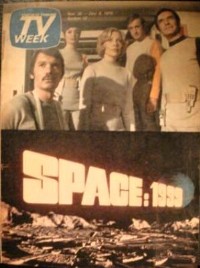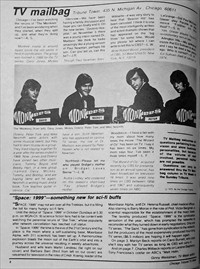Press
1976 Smash
by Lee Winfrey
Chicago Tribune, Tuesday, October 21, 1975.
A new kind of artificial snow has been invented for the Space: 1999 television series. Although it's an imitation, it melts just like the real stuff.
Martin Landau and Barbara Bain, the stars of Space, told me about the snow and the future course of the series in an interview in Philadelphia, where they came to appear on The Mike Douglas Show.
Space: 1999 is important because it fills a need. It satisfies a genuine hunger in the TV audience: a national longing for a good new science-fiction series. The networks, economically fat and creatively stale, seem locked into a mind-set incapable of imagining anything but new cops and sitcom spinoffs. Space: 1999 is a handsome rebuke to that kind of thinking.
Landau and Bain, husband and wife, made their TV reputation in 1966-69 as two of the stars on the much-admired Mission: Impossible series. Then cast as Rollin Hand and Cinnamon Carter, they are aloft now as Commander John Robert Koenig, and Dr. Helena Russell on Moonbase Alpha, the locale of Space: 1999.
Koenig and Russell were up on the moon with 309 other people when a nuclear explosion blew the moon out of orbit. For 24 weeks this winter, they will travel through space having adventures. Landau said a decision was "imminent" on whether to do a second season of shows, but so far all signs read go.
The artificial snow appeared on a recent episode in which Moonbase Alpha encountered a planet composed entirely of snow and ice. Landau said the new melting snow, developed for this show, is made from a detergent. Formerly, if you wanted melting snow on a TV show, you had to go out on location and find some of the real stuff.
Space was filmed at Pinewood Studios near London, with all the special effects done in another studio about 10 miles away. Landau said the special effects, which are many and elaborate, made the show difficult to act in at the start.
"It took a while," said Landau, "before all the special effects would arrive on the same day when we were scheduled for filming. So often we'd have to act against the background of a blank screen, not knowing exactly what the special effects would look like when they were placed there.
"So we would constantly be asking How big is it?' or How badly will he be burned?' If someone is burned, for example, you don't want to be blanching in horror, only to learn later that the sight you're blanching at is only a finger with a blister."
More than once, the stars said, the special effects were dangerous. "You can't have an explosion without using gunpowder," said Landau, "and anytime you use gunpowder, that's dangerous. We blew up a lot of sets."
Part of one mishap will be seen on screen, said Bain. "One day a piece of fire fell on one of the people," she said. "The director ran into the scene and snuffed out the person's clothes. The man with his suit ignited will be seen. The director just cut out the part where he put out the fire."
Landau and Bain are full of enthusiasm about Space, which is running in 100 other countries besides the U.S. Asked about future plots of the show, they bounce them out like tennis balls.
"We encounter a space brain." said Bain, "which proceeds to reject us. Much like the human body sometimes rejects an artificial transplant."
"There is another episode in which a baby is born in our group, called the Alpha child," said Landau. "In only five or six minutes it grows to the size of a six-year-old."
"We encounter our own ancestors, cave men and women" said Bain. "Then we encounter ourselves five years later," said Landau.


Chicago Tribune TV Week cover and p2, Nov 30-Dec 6, 1975.
"SPACE: 1999" may not win over all the Trekkies, but it is filling the bill for many hungry sci-fi fans.
Until the debut of "Space: 1999" in October (Sundays at 5:30 p.m. on WGN-Ch. 9) science fiction fans had to be content with watching the perennial reruns of "Star Trek," whose popularity after network cancellation has reached cult status.
In "Space: 1999" the time is the eve of the 21st Century and the place is the moon where a self-sustaining base, Moonbase Alpha, with 311 scientists has been set up. A thermonuclear explosion blasts the moon out of the Earth's orbit and into a journey across the universe resulting in weekly adventures.
Husband and wife team Martin Landeau (far right on our cover) and Barbara Bain (third from left on our cover) are reteamed for television in the roles of Cmdr. Koenig, leader of the Moonbase Alpha, and Dr. Helena Russell, chief medical officer. Also starring is Barry Morse in the role of Prof. Victor Bergman, a scientist responsible for the establishment of the moon base.
The lavishly produced "Space: 1999" is the syndication sensation of the year, which has prompted the networks to reconsider what they turned down in early negotiations. Only one TV series, "The Saint," has gone from syndication to the network, but the producers of the most expensively produced hour-long TV series ($6.5 million) are hoping it will happen again.
Ginny Weissman, TV Week editor
Space: 1999 copyright ITV Studios Global Entertainment
Thanks to Robert Ruiz